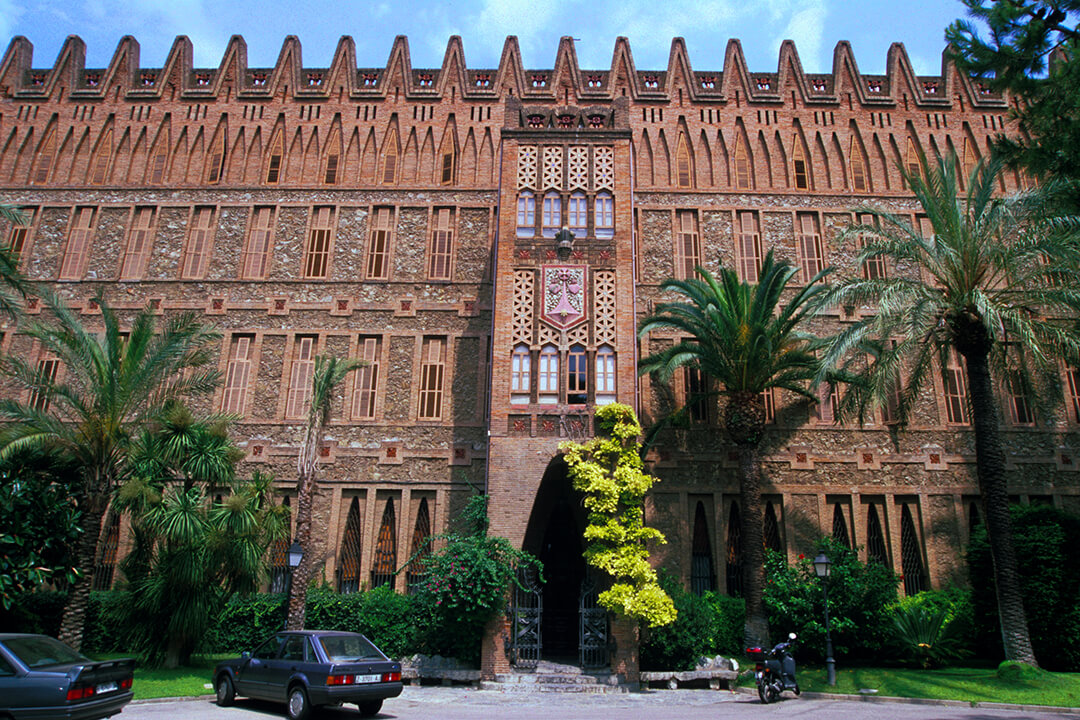Home / Modernisme work /
Col·legi de les Teresianes
1888
Antoni Gaudí i Cornet
Reus (1852) - Barcelona (1926)

Gaudí was commissioned to build this spiritual fortress of Saint Theresa. To carry out the commission, Gaudí read the mystical works of the Catholic saint, and it shows. The symbolism of Saint Theresa is everywhere, as in the T-shaped columns at the end of the cloister corridor. In the centre of the ‘fortress’ there is another column, but it is very simple, because Gaudí imagined that the centre was God’s place and he considered that he could not pretend to create anything to match such absolute beauty. The entrance door is also full of religious details, such as the initials of Jesus, although there are also patriotic references in the wrought-iron four-striped Catalan flag. The characteristic Gothic arches of the building represent the symbol of prayer: the parabolic arches on the façades of the building (windows and ornamental motifs) are continued inside. In the corridors of the first floor, the rhythmic presence of these arches generates an interplay of light and shade that enhances the space giving it the feeling of a convent cloister. Gaudí even designed the plant pots, which had to be orange and green in colour. Orange as the symbol of the Holy Trinity, in which yellow is the Father, red the Son and orange, the mixture, is the Holy Spirit. At the corners of the building Gaudí built helicoidal brick pillars with the coat of arms of the Theresian religious order in ceramic, crowned with four-armed crosses. Another interesting element is the chimney, similar to those in Palau Güell, that presides over the roof terrace of the building. In 2002 the Barcelona Urban Landscape Institute recovered elements and emblems of the façade, and replaced the peculiar “birretas” which had disappeared during the Spanish Civil War -University doctoral caps, yat another sybol of Saint Theresa- back on the roof battlements.
Actions on Modernista Heritage City Council Programme Barcelona, posa’t guapa (Barcelona, get pretty)
Restoration of various special elements of the crown, coats of arms on the façade and capstones on the battlements.
The nuns themselves sometimes organize guided visits to the school: ask the guard at the door or call 932 123 354 In 1888.
Get the Guidebook of Barcelona Modernisme Route
The Barcelona Modernisme Route is an itinerary through the Barcelona of Gaudí, Domènech i Montaner and Puig i Cadafalch, who, together with other architects, made Barcelona the great capital of Catalan Art Nouveau. With this route you can discover impressive palaces, amazing houses, the temple that is symbol of the city and an immense hospital, as well as more popular and everyday works such as pharmacies, shops, shops, lanterns or banks. Modernisme works that show that Art Nouveau took root in Barcelona and even today is still a living art, a lived art.
The Guidebook of Barcelona Modernisme Route can be acquired in our centers of Modernisme.


